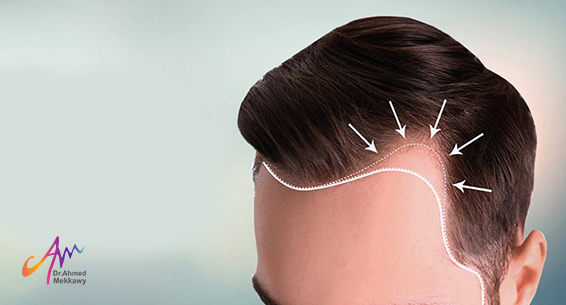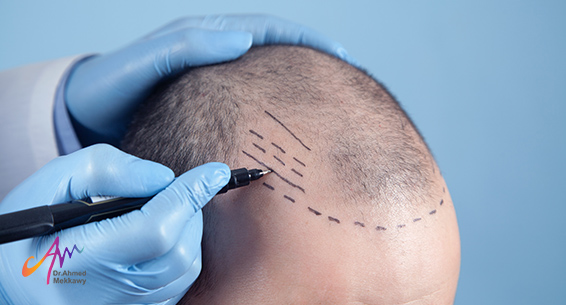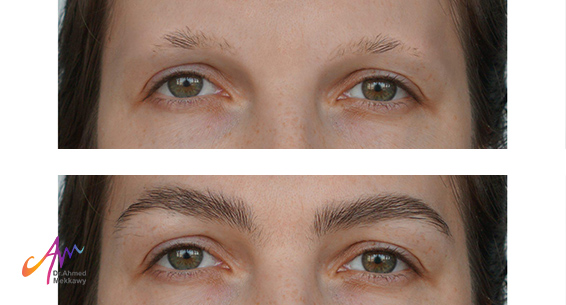Hair Transplant for Forehead Reduction

Hair Transplant for Forehead Reduction
Some women experience the challenge of having a large forehead and often seek ways to conceal it. Join us as we explore an alternative to surgical forehead reduction, which is the hair transplant for forehead reduction, a procedure pioneered by Dr. Ahmed Mekkawy.
Reasons for going for Hair Transplant for Forehead Reduction:
• Desire to achieve a smaller forehead size without resorting to surgical methods.
• Women experiencing hair loss and a receding hairline.
• Women with elevated hairlines, resulting in the appearance of a large forehead.
• receding hairline due to aging or hormonal changes in the body.
• Desire to reshape the front hairline for better facial structure.
Guidelines Prior to Undergoing a Hair Transplant for Forehead Reduction:
• Avoid smoking before the injection procedure.
• Avoid blood thinner medications, such as aspirin.
• Some tests might be required by the doctor before the procedure.
• The doctor might also prescribe specific medications to be taken prior to the injection procedure.
Steps of the Hair Transplant for Forehead Reduction Procedure:
• Dr. Ahmed Mekkawy assesses the areas where he will extract the hair follicles.
• He then identifies the areas where hair will be transplanted and distributed.
• He uses a local anesthetic to numb the scalp.
• Hair follicles are carefully extracted from the designated areas.
• These follicles are cleaned and prepared for re-implantation.
• The follicles are transplanted into the predetermined areas on the forehead.
Post-Transplant Guidelines for Optimal Results:
During the recovery process, adhering to recommendations can yield the best outcomes and minimize potential side effects, including:
• Avoiding intense physical exertion for a period of time and stopping smoking, alcohol, and caffeine. This ensures an adequate blood supply to the scalp to prevent the death of the newly transplanted follicles.
• Following the doctor's instructions regarding hair washing and changing medical dressings.
• Avoiding scalp scratching or applying excessive pressure on the newly transplanted follicles to prevent dislodging them.
• Maintaining a healthy, nutrient-rich diet to promote hair growth.
Risks Associated with Hair Transplant for Forehead Reduction:
During the initial recovery phase, there might be some temporary side effects, such as:
• Swelling, which is a common occurrence after hair transplantation. It diminishes over time and can be alleviated by applying cold compresses to the donor area.
• Minimal bleeding, which is usually natural. However, if bleeding persists or is substantial, immediate consultation with the doctor is advised.
• Bruising might occur but will fade without leaving any lasting marks.
• temporary itching, which subsides with time. It's crucial to avoid scratching the scalp to avoid any negative impact on the procedure.
• Pain or headaches can be managed with the pain relievers recommended by the doctor.
• The likelihood of infection is rare due to Dr. Ahmed Mekkawy's rigorous sterilization procedures. If an infection occurs, antibiotics prescribed by the doctor can effectively treat it.
Results of a Hair Transplant for Forehead Reduction:
Visible results from the hair transplant for forehead reduction procedure appear within six months. Transplanted hair follicles stabilize and begin adopting the characteristics of the recipient area.
Typically, the success rate of a hair transplant is around 99.6% for suitable candidates.
While final results might take longer in some cases due to individual hair growth rates and follicle density. Results are generally evident within a year, achieving a smaller forehead without the need for surgical intervention.
Frequently Asked Questions about Natural Hair Transplant:
Am I a suitable candidate for a hair transplant?
Ideal candidates for hair transplants should fulfill these criteria:
• Good overall health without chronic conditions that could hinder the procedure, such as heart disease, hepatitis, or diabetes.
• Adequate hair density at the back of the head to cover the areas experiencing hair loss.
• Age above 20, as hair transplants can be performed between ages 20 and 60.
• Willingness to adhere to Dr. Ahmed Mekkawy's instructions before and during the recovery process.
Is the hair transplant procedure painful?
Absolutely not. The hair transplant procedure is painless, as local anesthesia is administered before the procedure begins. There might be a brief moment of discomfort from the anesthesia injection, but it only lasts for a few seconds.
Are the results of a hair transplant permanent?
The outcomes of a hair transplant are permanent, provided there are no underlying chronic conditions causing ongoing hair loss. Transplanted follicles adapt to their new location's characteristics and appear entirely natural.
Should I go for a medical facility for a hair transplant?
Yes, it's advisable to undergo a hair transplant procedure in a well-equipped medical facility. This ensures a sterile environment that safeguards the extracted follicles and prevents infection.
Is it possible to perform a natural hair transplant from one person to another?
Currently, performing a natural hair transplant from one person to another is not feasible due to the body's immune response to foreign follicles. However, synthetic hair transplants might be an option for individuals with complete baldness.
What's the purpose of post-transplant PRP sessions?
Post-transplant PRP sessions stimulate the growth of transplanted hair follicles and supply them with essential nutrients, which prevents follicle loss during the recovery phase and guarantees the best possible results after the transplant.
Cost of a Natural Hair Transplant:
The cost of a natural hair transplant varies based on several factors, including:
• Number of hair follicles to be transplanted.
• Transplant technique and anesthesia type.
• Accommodation costs for patients coming from abroad.
• Hospital expenses and medical team fees.
At Dr. Ahmed Mekkawy's clinic, the cost starts at $1200. This comprehensive fee covers the transplant procedure, recovery kit, and a post-transplant PRP session. The cost of medical tourism starts at $1500, including a two-night stay, transportation, a PRP session, and a recovery kit.
Attaining a more proportionate forehead is an aesthetic goal. Don't hesitate to consult Dr. Ahmed Mekkawy, a specialist in plastic surgery and hair transplant, to achieve optimal results from this procedure with the leading hair transplant doctor in Egypt.
This content has been reviewed by Dr. Ahmed Mekkawy, a consultant in cosmetic surgery, body contouring, and natural hair transplantation.


.jpg)